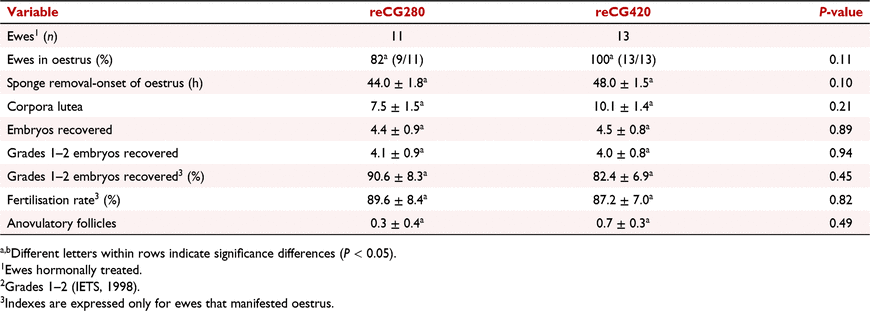165 Superovulatory response and embryo production using a bioactive recombinant equine chorionic gonadotrophin in sheep
M. Bruno-Galarraga A , J. Fernandez A , M. Cueto A , L. Cattaneo B , C. Prieto B C , S. Antuña C , B. Tardivo C , D. Fontana B C , G. Bó D E and A. Gibbons AA Instituto Nacional de Tecnología Agropecuaria (INTA EEA Bariloche-IFAB INTA-CONICET), Bariloche, Rio Negro, Argentina
B Universidad Nacional del Litoral, Santa Fe, Argentina
C Biotecnofe S.A., Córdoba, Argentina
D Universidad Nacional de Villa Maria (UNVM), Córdoba, Argentina
E Instituto de Reproducción Animal Córdoba (IRAC), Gral Paz, Córdoba, Argentina
Reproduction, Fertility and Development 34(2) 320-321 https://doi.org/10.1071/RDv34n2Ab165
Published: 7 December 2021
© 2022 The Author(s) (or their employer(s)). Published by CSIRO Publishing on behalf of the IETS
In sheep, the use of a single dose of 1000 IU of serum eCG has been described to induce superovulation and produce transferable embryos (3.0 ± 0.9 per donor ewe) at a reduced cost, but the presence of anovulatory follicles (1.7 ± 0.8), could harm embryo development (Cueto et al. 2020 Revista Argentina Producción Argentina 40(Suppl.1), abst). The development of a new recombinant equine chorionic gonadotrophin (reCG) evaluated in cows has recently been published (Villarraza et al. 2021 Theriogenology 172, 8-19). The objective of this study was to evaluate the potential of reCG on the induction of superovulatory response and embryo production in sheep. The study was carried out in the Laboratory of Reproduction in Small Ruminants of INTA Bariloche during the breeding season (May, 41°S). Merino sheep (n = 24; 4 years old; body weight of 41.5 ± 2.5 kg and body condition score of 2.5 ± 0.2) were treated with intravaginal sponges (60 mg MAP Progespon®, Syntex) for 14 days. At the time of sponge removal, ewes were assigned randomly to two treatments to receive a single dose of 280 IU (reCG280, n = 11) or 420 IU (reCG420, n = 13) of reCG (Folirec®, Zoovet). Oestrus detection was performed every 12 h, from 24 to 48 h after sponge removal, using an adult teaser ram. Forty-eight hours after sponge removal, laparoscopic intrauterine insemination with frozen/thawed semen (100 × 106 sperm per ewe) from a single ram of proven fertility was performed only in ewes that showed oestrus. On Days 7 and 8 after sponge removal, the number of corpora lutea (CL) was assessed by laparoscopic observation. Embryo recovery was carried out using the technique described by Gibbons et al. (2011 Small Rumin. Res. 95, 61-64). The collected embryos were classified morphologically based on the guidelines of the IETS. The ovulatory response and embryo production were compared between treatments using ANOVA test. A total of 91.6% ewes were observed in oestrus (22/24) between 24 and 48 h after sponge removal (9 and 13 ewes for reCG280 and reCG420, respectively). Both dosages were able to induce superovulation and no differences were detected in all end points evaluated (Table 1). This study reports, for the first time, that reCG can produce an acceptable superovulatory response and good embryo production in sheep. These results have important implications as an alternative for control of the ovulatory response using a synthetic recombinant hormone without the need to use animals for its manufacture.

|


